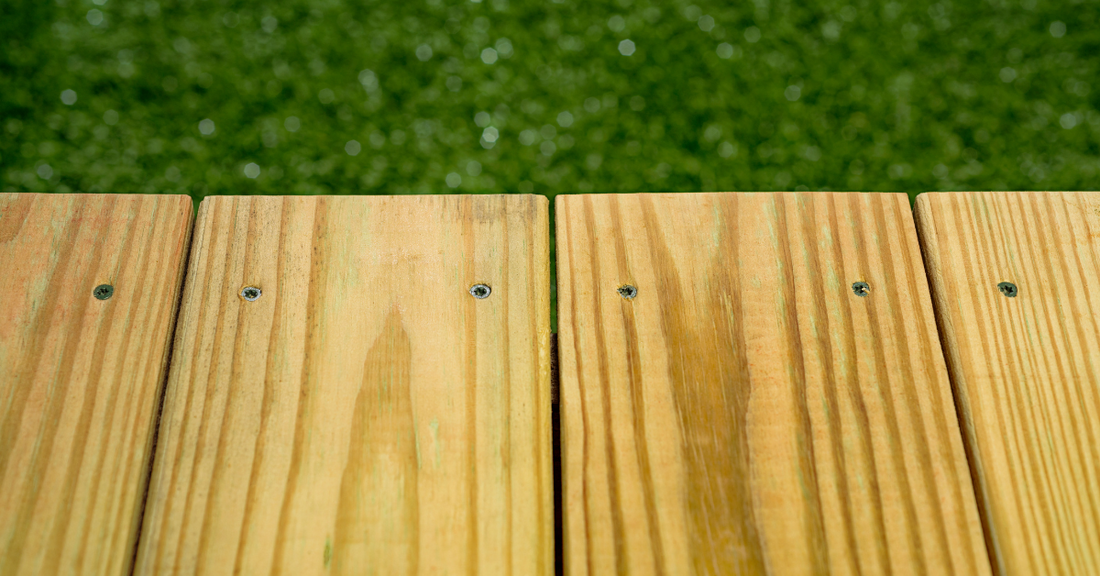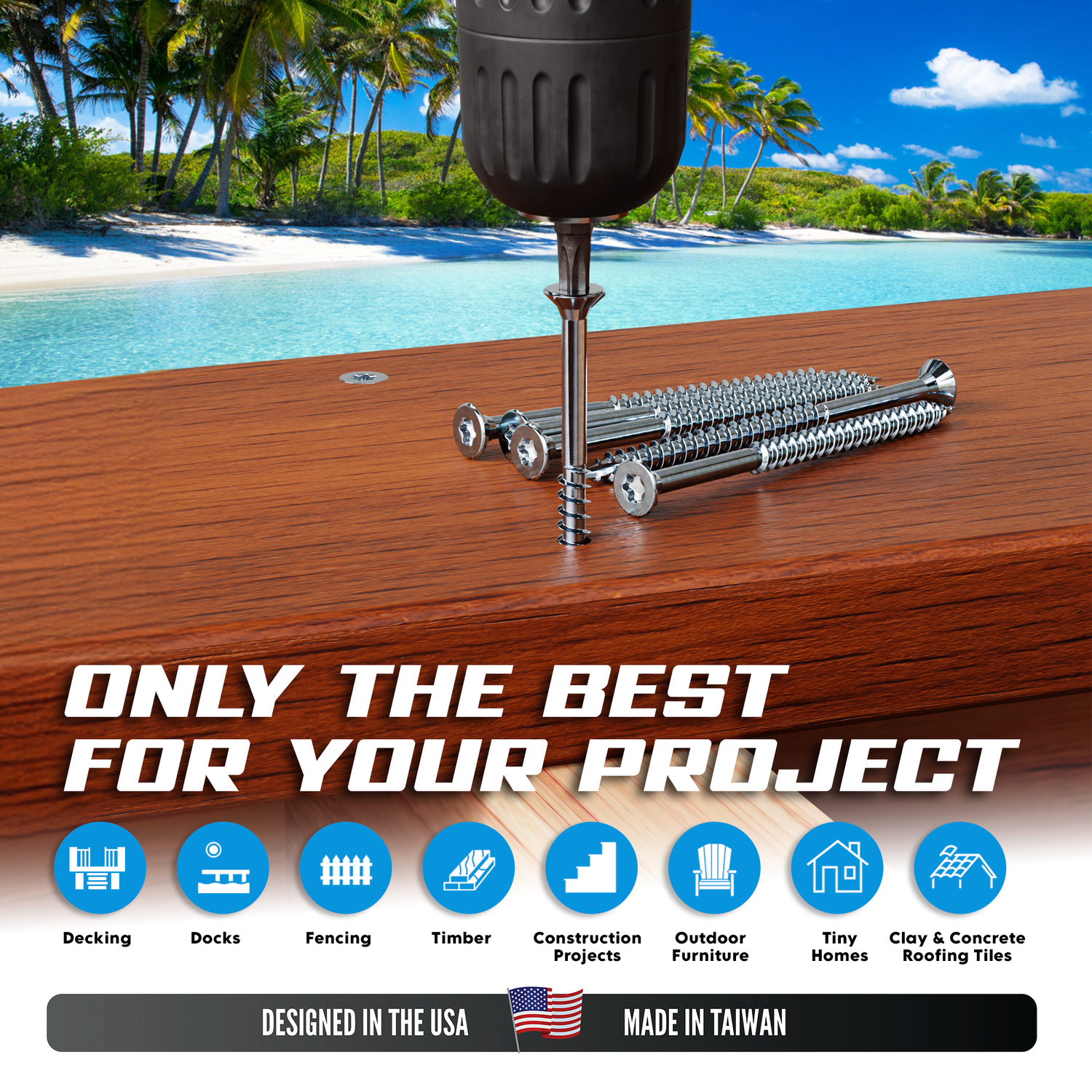
Understanding Wood Screw Load Capacity for a Sturdy Structure
Share
A screw's load capacity is the highest weight or force it can handle safely before it breaks. Buying the first box of “big screws” you see isn’t the best way to choose the fasteners that can handle the weight of your overall structure.
Not every screw you see in big box stores and here online is the same. Different wood screw makers design their screws in different ways. They use different thread patterns, tip designs, shank features, heads, and ribs. Each feature affects how well the wood screw can hold weight.
So, how would one know how much weight a wood screw will hold?
The safest way to know how much weight the screws will hold is to read the label or check the manufacturer's website. This is the best source for information about how much weight a screw can hold.
Companies share information about how strong the screw is when pulled apart, how well it holds up under pressure, and how it resists rust and damage from the environment. All of these factors directly affect the amount of weight the screw can support.
- Tensile strength: The maximum strength that it would take to pull the screw totally.
- Shear strength: How well the screw can handle sideways forces, such as weight pushing against it from the side.
- Corrosion resistance: How well the screw can handle different weather conditions. Are the screws reliable in coastal areas? Can they only be used in mild environments?
How Screw Design Affects Wood Screw Load Capacity

Screw Size (Gauge and Length)
When you're figuring out which screw to use for your timber construction, the size is the first thing you'll need to think about. Getting the right screw size is key to keeping everything stable and making sure it can handle all the weight. So, there are two important factors to consider: the screw gauge, which is basically the diameter, and then there's the length of the screw.
Screw Gauge (Diameter)
A screw gauge is the measurement of the screw's diameter. Bigger wood screws, like #10 or #12, are thicker. These gauges give the screws more surface area for better grip, allowing them to carry more weight. Use larger screws when you're building heavy-duty wood structures.
Why is gauge important for load capacity?
- Pine and cedar are types of softwoods that are lighter and more flexible, so using #8 or #9 gauge screws works best. These smaller screws offer a strong hold without the risk of splitting the wood.
- Hardwoods such as oak, maple, or teak are tougher and less likely to get damaged easily during installation. Use #9 to #10 gauge screws for hardwood structures. These screws are thicker and work better for gripping the dense fibers securely.
If you're making furniture out of pine, using #8 screws is a good choice since the wood is softer. To build a strong workbench using oak, you should use #9 or #10 screws. These will provide a secure hold and reduce the chances of the screws slipping or breaking.
Screw Length
Screw length is about how far the screw goes into the material. Selecting the right length is important for making sure you have a strong and safe connection.
Use a screw that's too short, and the screw won’t have enough purchase to fasten the material tightly. Use a screw that is too long, and the screw can stick out from the other side and damage the material.
In our years in timber construction, we choose the screw length based on the thickness of the board. The screw should go into the structure at least 2 to 3 times the thickness of the material being fastened. This ensures the screw is long enough to form a strong, durable connection without damaging the wood.
Why is length important? :-)
- Thinner materials, like 1-inch-thick boards, need a shorter screw that will hold onto the material without poking through the other side. 2 ½ to 3” inch screws are usually perfect for materials that are 1 inch thick.
- Thicker materials, like 1 ½ -inch-thick boards, need longer screws. Use 3 ½ to 4-inch screws so that the screw goes deep enough into the material for a strong grip.
When fastening two thin materials together, you may find you don’t have much ‘meat’ for the screws to gain purchase into. Consider adding glue to the joint for extra strength.
The Material of the Screw
The material it’s made from also affects its strength, resistance to corrosion, and suitability for your specific woodworking project.
We've always found stainless steel wood screws are best to use in all outdoor wooden structures. Coated steel screws, such as galvanized screws, provide some level of protection against rust. However, coated screws won't last as long as stainless steel screws, especially in harsh environments like high humidity or exposure to saltwater.
When to Use 304 Stainless Steel Screws

304 SS wood screws can withstand a moderate level of moisture. However, they aren't the best stainless steel grade for areas with a lot of salt or heavy rains.
Moderate humidity means places where the relative humidity usually falls between 50% and 70%. This level of humidity is experienced in:
- Places in a house where the air is more humid, like kitchens, bathrooms, or basements.
- Areas outside the city where it rains regularly, but not too much.
- Wooden structures that might experience rain or snow
- Structures that are not 3 miles (5 kilometers) from the ocean or affected by saltwater.
304 SS screws are not as strong as 316 SS. However, they last longer than coated steel screws, which makes them a reliable option for these environments.
When to Use 316 Stainless Steel Screws
In places where it's really humid, like near the coast, where there's saltwater, or in factories, 316 stainless steel screws are the best option. The added molybdenum in stainless steel makes them more resistant to corrosion, especially against chlorides (salt).
316 SS screws work great when the humidity is usually over 70%.
- Coastal areas: Subject to salty air and constant high levels of humidity.
- Marine environments: Places that are always in contact with saltwater, like where boats are used or where docks are built.
- Swimming pool areas: Places where the air or water has a lot of chlorine.
What’s the best for better load capacity? To keep your wood structure safe from the weather, pick 316 stainless steel wood screws.

Thread Type and Design
The thread count (how many threads there are per inch) and pitch (the spacing between each thread) are important factors in how effectively a screw holds onto the material. Coarse threads are thicker and more spaced out, while fine threads are tighter and more detailed.
Coarse Threads
Wood screws usually have coarse threads. Coarse threads help the screw bite into the wood better, making a strong connection without breaking or splitting the material.
Coarse threads bite deeper in the material which provides better holding power. Screws with coarse threads are a great choice for working with pine, spruce, fir, and other softwoods. The screw drives in quickly and holds exceptionally well, ensuring that it can handle load and that it stays secure over time without loosening or pulling out.
Fine Threads
When it comes to harder materials, like redwood, teak, and oak, fine threads work best.
Hardwoods are much more dense than softwoods. So, if you want to build a project out of oak, you need screws that can bite into the wood sufficiently without requiring excessive torque to drive. Fine threads have a higher thread count per inch, which means they drive slightly slower.
What’s the best option for improving load capacity? The choice of the thread type is influenced by both the material used and the amount of weight the screw has to hold, but ultimately a larger screw gauge is what makes the connection stronger and more stable.
Screw Head and Drive Type
The head and drive type affect how well the screw works when it's being driven into the wood, how much torque it can handle, and how well it stays in place over time.
Screw Head Design
Flathead: The flat head is made to sit flat with the surface, which helps distribute the holding force evenly. This feature reduces the likelihood of the screw head sinking too deep into the material when being driven.
Roundhead: The roundhead screw is more suitable for situations where how it looks matters more than its holding power.
Hexhead: Hexhead screws are great because they let you use more torque when you install them. This makes them perfect for tough projects where you really need strength and stability. Generally this head type is used for heavy duty applications.
Screw Drive Type
Philips Drive: Philips screws work well for everyday jobs, but they might not be the best choice for high-torque tasks where you really need strong grip and torque transfer.
Slotted Drive: Slotted screws are best driven with hand screwdrivers. Although they have a wonderful retro look in certain applications, we do not recommend them for use with drills and impact drivers.
Torx Drive: The best deck screws are made with Torx heads. It's because Torx screws have excellent torque transfer.They're perfect for tough jobs and repetitive driving. So you'll never have stripped heads when using these screws.

Robertson Drive: The Robertson drive offers great torque transfer, but Torx drive screws allow the driver bit to enter the head more easily, as well as having a smoother release. A further advantage of the Torx drive is that the rounder recess is more aesthetically pleasing than the square of the Robertson, especially in the case of multiple screws placed close together.
What’s the best bet for reliable driving? Torx, also called Star or 6-Lobe, is your best bet every time.
Why Eagle Claw Stainless Steel Wood Screws Are the Strongest Type of Wood Screw
Eagle Claw stainless steel wood screws are expertly designed for exceptional load-bearing strength, featuring sharp, precise threads that ensure a strong grip and even force distribution. The Torx drive head improves torque transfer, ensuring a tight, secure fit even in tough materials like hardwood, while also protecting both the screw and your power drills from damage.
Our screws are available in 304 and 316 stainless steel, making them stronger than every other wood screw out there. Built to last, our screws are designed to manage heavy loads over the years, delivering dependable performance for all your woodworking projects.
FAQs
Do screws have good tensile strength?
Yes, screws have incredible tensile strength. They form a strong connection between two pieces of wood, making it really hard to separate them. Screws can take on a lot of pulling force before they snap. So, when it comes to holding materials together under tension, screws are better than nails and other fasteners.
Do wood screws require pre-drilling?
Yes, wood screws can require pre-drilling. If screws are driven too near the edge, if the material is thick, and if you're using bigger screws, there's a chance that the screw could cause the wood to split.
Pre-drilling wood screws on your every build lessens pressure on the wood as you drive them in. If you pre-drill, you're making enough room for the screw's threads to hold on tight.


